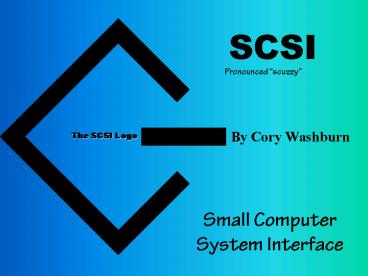SCSI - PowerPoint PPT Presentation
1 / 16
Title:
SCSI
Description:
Internet SCSI (iSCSI) is an official standard ratified in 2003 by the Internet Engineering Task Force that allows the use of the SCSI protocol over TCP/IP networks. – PowerPoint PPT presentation
Number of Views:564
Avg rating:3.0/5.0
Title: SCSI
1
SCSI
Pronounced scuzzy
By Cory Washburn
The SCSI Logo
Small Computer System Interface
2
What is SCSI?
- SCSI is a set of standards for physically
connecting and transferring data between
computers and peripheral devices. - The SCSI standards define commands, protocols,
and electrical and optical interfaces. - SCSI is mostly used for hard disks and tape
drives, but it can connect a wide range of other
devices.
3
How it Works
- A computer is full of busses, pathways that take
information and power from one place to another.
For example, when you plug an MP3 player into
your computer, you're probably using a USB port.
Your USB port is good at carrying the data and
electricity - required for small electronic
- devices, but that bus isn't big
- enough to support a whole
- computer, a server or lots of
- devices simultaneously. For
- that, you'd need SCSI.
4
How it Works Continued
5
SCSI Command Protocol
- Communication takes place between an initiator
and a target. The initiator sends a command to
the target which then responds. SCSI commands are
sent in a Command Descriptor Block (CDB). The CDB
consists of a one byte operation code followed by
five or more bytes containing command-specific
parameters.
- There are 4 categories of SCSI commands N
(non-data), W (writing data from initiator to
target), R (reading data), and B
(bi-directional). There are about 60 different
SCSI commands in total some common ones are - Inquiry, Send diagnostic, Start/Stop unit, Read,
Write
6
Why use scsi?
- Most workstations use the IDE interface. Probably
the reason is that IDE drives are cheaper than
SCSI type devices. For most workstation usage,
the IDE interface is more than adequate. But if
high speed disk access is crucial, the choice
should be SCSI. - Besides the speed issues, another important
feature of SCSI interfaces is that backwards
compatibility has been incorporated in all new
improvements. Different SCSI technologies can be
mixed on the same machine.
7
History
- In the 1970's - SASI, the Shugart Associates
System Interface was developed as an 8-bit system
bus. The SASI interface defined a logical level
rather than a device level interface to disk. - In 1982 After rejection and improvement in 1978,
SASI was again submitted to ANSI which then used
it as the foundation for the SCSI standard. - By 1983, SCSI had matured to the point that NCR
began shipping the first SCSI chipset. - In 1986 SCSI-1 was approved by ANSI.
- In 1994, extensions to SCSI-2 were finalized.
8
History Continued
- 2001 SCSI Trade Association started Serial
Attached SCSI (SAS), designed to be the evolution
of SCSI to satisfy requirements of scalability,
performance, reliability and management, while
leveraging a common low-cost electrical and
physical connection interface from SATA.
- Internet SCSI (iSCSI) is an official standard
ratified in 2003 by the Internet Engineering Task
Force that allows the use of the SCSI protocol
over TCP/IP networks.
- 2004 - BiTMICRO Networks announced the
availability of the world's first Ultra320 SCSI
solid-state flash storage.
9
Types
10
SCSI 1 and 2
- SCSI-1 is what started it all, and is now
obsolete. SCSI-1 involved the specs for the basic
8-bit SCSI bus, with about 5 MBs transfer rate.
11
SCSI-3/SPI
- SCSI-3 differs from SCSI-2 in that it contains
many more new features, technologies, and command
sets. This interface has evolved into SPI-2,
SPI-3, and SPI-4.
- The original SPI worked with parallel SCSI as
well as Fast SCSI. Transfer rate was increased to
40mb/s. - As well as doubling the transfer rate, SPI-2
added even more changes, which included Low
Voltage Differential Signaling (LVD), multimode
devices, and new connectors. LVD has pretty much
replaced HVD in modern SCSI systems, and it's
even required for the fastest SCSI buses. Ultra2
SCSI and Wide Ultra2 SCSI are the informal
marketing terms for devices that use the SPI-2
standard. - The SPI-3 standards again doubled the transfer
rate to 160 MB/s. Lots of performance
enhancements were added as well as removing some
obsolete standards.
12
Ultra SCSI
SAS
- The newest type of SCSI, called SAS, uses SCSI
commands but transmits data serially. SAS uses a
point-to-point serial connection to move data at
3.0 gigabits per second, and each SAS port can
support up to 128 devices or expanders.
- The first level of Ultra is just called Ultra and
has a data transfer rate of 20 MB/s w/o a wide
bus - The second is called Ultra2 with 40 MB/s. Ultra2
is also the last type of SCSI to have a narrow
bus width of 8 bits - The third is called Ultra3 and has a rate of 160
MB/s - The fourth is Ultra320 and this one doubled the
last with a 360 MB/s transfer rate
13
ISCSI
- Short for Internet
- SCSI, its an IP-based
- standard for linking
- data storage devices
- over a network and
- transferring data by
- carrying SCSI
- commands over IP
- networks. iSCSI
- supports a Gigabit
- Ethernet interface.
14
Manufacturers
Price
ACARD Technology CorporationAdaptec,
Inc.Amphenol CorporationCompaq Computer
CorporationDallas SemiconductorIBM Corp.LSI
Logic CorporationLinfinity Microelectronics
Inc.Maxtor Mylex CorporationQLogicQuantum
Corp.Seagate TechnologyTexas InstrumentsWieson
Electronic Co., Ltd.
- For SPI adapters, the prices range from 4 to
over 100
- Termination Interfaces are usually only a few
dollars
- Hard drives and other devices using SCSI have
varied prices
- SCSI host adapter prices can range from 20 to
1000s of dollars
15
Chart
16
Sources
http//www.scsilibrary.com/iscsi.html
http//lowendmac.com/tech/scsi-history.shtml
http//cs.haifa.ac.il/courses/network_mem/scsi.htm
l
http//www.connectworld.net/cis/scsi.html
http//www.slcentral.com/articles/01/2/scsi/page4.
php
http//www.scsita.org/terms/scsiterms.html
http//computer.howstuffworks.com/scsi2.htm































